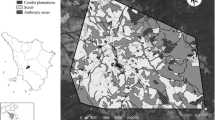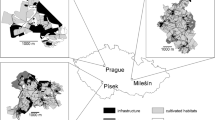Abstract
Studies of rock ptarmigan Lagopus mutus in northern latitudes have shown that, in the breeding season, the majority of cocks pair monogamously and defend small territories, whilst in most populations, a small proportion of cocks are polygynous or remain unmated. Little is known, however, on spacing behaviour and habitat use of alpine rock ptarmigan populations occurring at low densities at the southern edge of the species’ range. From 1995 to 1997, we trapped, radio-tracked and observed birds in the Central Italian Alps (elevation 2,000–3,000 m) in order to investigate spacing behaviour and habitat use in alpine landscapes where habitats offering rich food and cover are patchy. Both sexes were selective in their habitat use, and cocks did not establish territories on bare ground, artificial or nutrient rich grasslands or bogs. In the breeding season, cocks had larger home ranges than hens (cocks 99 ± 57 ha, hens 50 ± 25 ha) that overlapped with the ranges of neighbouring cocks and hens. Cocks were monogamous and defended relatively large territories (core areas of home ranges: cocks 37 ± 26 ha, hens 24 ± 12 ha), which corresponded with low spring densities (0.47–2.29 cocks km−2 and 0.35–1.60 pairs km−2). Territory size of individual cocks was negatively correlated with the amount of high quality habitat in the core-area. Our results suggest increased home ranges and large breeding territories in low density alpine rock ptarmigan populations, compared to populations occurring at higher densities in the central and northern alps, and on subarctic and arctic grounds at northern latitudes, confirming the predictions of models on food-based territoriality.


Similar content being viewed by others
References
Bart J, Earnst SL (1999) Relative importance of male and territory quality in pairing success of male rock ptarmigan (Lagopus mutus). Behav Ecol Sociobiol 45:355–359
Bossert A (1980) Winterökologie des Alpenschneehuhns (Lagopus mutus Montin) im Aletschgebiet, Schweizer Alpen. Orn Beob 77:121–166
Bossert A (1995) Bestandsentwicklung und Habitatnutzung des Alpenschneehuhns Lagopus mutus im Aletschgebiet (Schweizer Alpen). Orn Beob 92:307–314
Bossert A, Marti C, Niedermauser F (1983) Zur Bestandsentwicklung des Alpenschneehuhns (Lagopus mutus Montin) im Aletschgebiet (Zentralalpen) von 1973–1983. Bull Murithienne 100:39–49
Boudarel P (1988) Recherches sur l’habitat et le comportement spatial du lagopède alpin dans Pyrénées occidentales françaises. Gibier Faune Sauvage 5:227–254
Caizergues A, Bernard-Laurent A, Brenot J-F, Ellison L, Rasplus JY (2003) Population genetic structure of rock ptarmigan Lagopus mutus in Northern and Western Europe. Mol Ecol 12:2267–2274
Carpenter FL, MacMillen RE (1976) Threshold model of feeding territoriality and test with a Hawaiian honeycreeper. Science 194:639–642
Commission of the European Communities (1993) CORINE land cover-technical guide. Office for Official Publications of the European Communities, Brussels
Cotter RC (1999) The reproductive biology of Rock Ptarmigan (Lagopus mutus) in the central Canadian Arctic. Arctic 52:23–32
De Franceschi P (1992) Pernice bianca. In: Brichetti P, De Franceschi P, Baccetti N (eds) Fauna d’Italia, vol. XXIX: Aves I: 708–721. Calderini, Bologna
De Franceschi P, Bottazzo M (1991) Caratteristiche vegetazionali di alcuni biotopi di riproduzione di Pernice bianca nel Tarvisiano ed in Carnia. In: Spagnesi M, Toso S (eds) Atti II Conv. Naz. Biol. Selvaggina 19:165–180. INBS, Bologna
Desmet JF (1988) Densité de peuplement en période de reproduction du lagopède alpin (Lagopus mutus helveticus, Thieneman 1829) en haute Vallée du Giffre (Haute-Savoie). Gibier Faune Sauvage 5:447–458
Fasel M, Zbinden N (1983) Kausalanalyse zum Verlauf der südlichen Arealgrenze des Alpenschneehuhns Lagopus mutus im Tessin. Orn Beob 80:231–246
Hannon SJ, Dobush G (1997) Pairing status of male willow ptarmigan: is polygyny costly to males? Anim Behav 53:369–380
Hoffman RW, Braun CE (1975) Migration of a wintering population of white-tailed ptarmigan in Colorado. J Wildl Manage 39:485–490
Holder K, Montgomerie R, Friesen VL (1999) A test of the glacial refugium hypothesis using patterns of mitochondrial and nuclear DNA sequence variation in rock ptarmigan (Lagopus mutus). Evolution 53:1936–1950
Holder K, Montgomerie R, Friesen VL (2000) Glacial vicariance and historical biogeography of rock ptarmigan (Lagopus mutus) in the Bering region. Mol Ecol 9:1265–1278
Huber B, Ingold P (1991) Bestand und Verteilung der Territorien des Alpenschneehuhns Lagopus mutus am Augstmatthorn BE. Orn Beob 88:1–7
Hughes L (2000). Biological consequences of global warming: is the signal already apparent? Trends Ecol Evol 15:56–61
Jacobs J (1974) Quantitative measurements of food selection. Oecologia 14:413–417
Kenward RE, Hodder KH (1996). Ranges V. An analysis system for biological location data. Institute for Terrestrial Ecology, Wareham, Dorset
Körner C (1999) Alpine plant life: functional plant ecology of high mountain ecosystems. Springer, Berlin Heidelberg New York
Kumstátová T, Brinke T, S, Fuchs R, Petrusek A (2004) Habitat preferences of tree pipit (Anthus trivialis) and meadow pipit (A. pratensis) at sympatric and allopatric localities. J Ornithol 145:334–342
Manly B, McDonald l, Thomas d (1993) Resource selection by animals: statistical design and analysis for field studies. Chapman and Hall, London
Marti C, Bossert A (1985) Beobachtungen zur Sommeraktivität und Brutbiologie des Alpenschneehuhns Lagopus mutus im Aletschgebiet (Wallis). Orn Beob 82:153–168
Martin K, Stacey PB, Braun CE (1997) Demographic rescue and maintenance of population stability in grouse—beyond metapopulations. Wildl Biol 3:295–296
Martin K, Stacey PB, Braun CE (2000) Recruitment, dispersal, and demographic rescue in spatially-structured White-tailed Ptarmigan populations. Condor 102:503–516
Nielsen OK, Pétursson G (1995) Population fluctuations of gyrfalcon and Rock Ptarmigan: analysis of export figures from Iceland. Wildl Biol 1:65–71
Novoa C, Gonzalez G (1988) Comparaison des biotopes sélectionnés par le lagopède alpin (Lagopus mutus) et la perdrix grise des Pyrénées (Perdix perdix hispaniensis) sur le Massif du Carlit (Pyrénées-Orientales). Gibier Faune Sauvage 5:187–202
Scherini GC, Tosi G, Wauters LA (2003) Social behaviour, reproductive biology and breeding success of alpine rock ptarmigan Lagopus mutus helveticus in northern Italy. Ardea 91:11–23
Seaman DE, Powell RA (1996) An evaluation of the accuracy of kernel density estimators for home range analysis. Ecology 77:2075–2085
Sokal RR, Rohlf FJ (1995) Biometry, 3rd edn. Freeman, New York
Steen JB, Unander S (1985) Breeding biology of the Svalbard Rock Ptarmigan Lagopus mutus hyperboreus. Ornis Scan 16:191–197
Storch I (2000) Grouse Status Survey and Conservation Action Plan 2000–04 (Compiler). IUCN, Gland and Cambridge, and the World. Pheasant Association, Reading
Unander S, Steen JB (1985) Behaviour and social structure in Svalbard Rock Ptarmigan Lagopus mutus hyperboreus. Ornis Scan 16:198–204
Verbeke G, Molenberghs G (2000) Linear mixed models for longitudinal data. Springer series in statistics. Springer, Berlin Heidelberg New York
Watson A (1965). A population study of ptarmigan (Lagopus mutus) in Scotland. J Anim Ecol 34:135–172
White GC, Garrot RA (1990) Analysis of wildlife radio-tracking rata. Academic, New York
Worton BJ (1989) Kernel methods for estimating the utilization distribution in home-range studies. Ecology 70:164–168
Acknowledgements
We thank Stefano Piccinini, the game wardens and hunters from the Bormio Hunting District for their help with the fieldwork. Constructive comments by Adam Watson greatly helped to improve the manuscript. The work was funded by the Servizio Faunistico of the Regione Lombardia.
Author information
Authors and Affiliations
Corresponding author
Additional information
Communicated by F. Bairlein
Rights and permissions
About this article
Cite this article
Favaron, M., Scherini, G.C., Preatoni, D. et al. Spacing behaviour and habitat use of rock ptarmigan (Lagopus mutus) at low density in the Italian Alps. J Ornithol 147, 618–628 (2006). https://doi.org/10.1007/s10336-006-0087-z
Received:
Revised:
Accepted:
Published:
Issue Date:
DOI: https://doi.org/10.1007/s10336-006-0087-z




